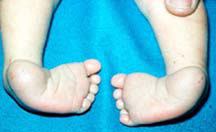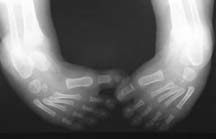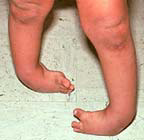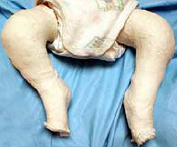Clubfoot has been one of the major orthopedic (bone and joint) problems of children since doctors began to specialize in the field more then 200 years ago. It is one of the most common of all birth defects, affecting some 9,000 babies (about 1 in 400) born in the United States each year. Boys are affected twice as often as girls.
What is clubfoot?
 Clubfoot can be mild or severe, and it can happen to one or both feet. In clubfoot, known medically as equinovarus, the foot is twisted inward and downward. If both feet have the problem, the toes point toward each other instead of straight ahead. The heel cord often is very tight, making it impossible to bring the foot up to a normal position without a specialist’s help.
Clubfoot can be mild or severe, and it can happen to one or both feet. In clubfoot, known medically as equinovarus, the foot is twisted inward and downward. If both feet have the problem, the toes point toward each other instead of straight ahead. The heel cord often is very tight, making it impossible to bring the foot up to a normal position without a specialist’s help.
What causes clubfoot?
 The exact cause of clubfoot still is not clear. In the past, it often was thought that the baby’s feet were twisted or cramped because of the way the baby laid in its mother’s womb. This is true only in rare cases that are easily corrected with casts. Many scientists think the defect starts early in pregnancy, before the baby is large enough to stay in one position very long. Clubfoot probably is caused by a combination of hereditary and other factors that may affect growth before the baby is born.
The exact cause of clubfoot still is not clear. In the past, it often was thought that the baby’s feet were twisted or cramped because of the way the baby laid in its mother’s womb. This is true only in rare cases that are easily corrected with casts. Many scientists think the defect starts early in pregnancy, before the baby is large enough to stay in one position very long. Clubfoot probably is caused by a combination of hereditary and other factors that may affect growth before the baby is born.
Although most children with clubfoot are otherwise normal, occasionally they have other orthopedic conditions such as developmental hip dislocation. Also, children with neurological conditions (such as spina bifida) may have an associated clubfoot. Clearly, most children with clubfoot are otherwise completely normal and, once the foot has been corrected, can be expected to live a healthy, normal life.
Examination
How does clubfoot affect a child?
 Clubfoot is not painful and it does not bother the baby until he or she begins to stand or walk. Since the foot is twisted in place, the foot/ankle cannot move up and down as it normally would in walking.
Clubfoot is not painful and it does not bother the baby until he or she begins to stand or walk. Since the foot is twisted in place, the foot/ankle cannot move up and down as it normally would in walking.
If both feet are affected, the child walks on the balls of the feet or, if the feet are badly twisted, on the sides or even the top part of the feet instead of the soles. The part walked on may become infected, hard and lumpy, and the entire leg often is unable to grow properly.
Psychological problems often rise when children find themselves walking differently from other children.
Treatment
 Treatment for clubfoot is started soon after birth, often during the first week of life. The aim is to move the twisted foot gradually and gently into a more normal position. This is achieved by a series of corrective casts. After serial cast treatment, many children require surgery to complete the correction. This is usually done when the child is between one and eight months of age.
Treatment for clubfoot is started soon after birth, often during the first week of life. The aim is to move the twisted foot gradually and gently into a more normal position. This is achieved by a series of corrective casts. After serial cast treatment, many children require surgery to complete the correction. This is usually done when the child is between one and eight months of age.
With expert early treatment, most patients grow up to wear regular shoes (one side may be a size smaller then the other if only one foot was affected), can take part in sports, and lead full and active lives. Since the cause is unknown, parents should not worry or feel guilty that something that occurred during pregnancy somehow caused the clubfoot. There is no evidence to support this theory.